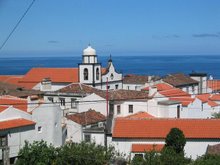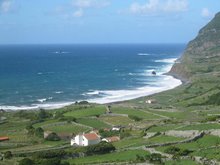Anyway, in 55BC (although it might have been 55AD, I can never remember) the Romans landed in Britain to find it peopled by a race called Celts. Which ought not to have come as too much of a surprise to them because a lot of western Europe was as well: France (Gauls - Asterix et al) but also what's now Spain and Portugal was Celtic then too.
But in the British Isles, the Romans found two distinct types of Celts: "P-Celts" and "Q-Celts". The former lived in Great Britain and the latter in Ireland (although the Romans never attempted to conquer Ireland).
The distinction was linguistic. Apparently P-Celts could not pronounce a hard "c" and replaced it with a "p" whereas Q-Celts could do a hard "c" - as the actress said to the bishop. Anyway, while an Irish Q-Celt would have no bother ordering a Big Mac and a regular Coke, a benighted British P-Celt would be asking for a "Big Map and a regular Pope". Thus, Welsh princes (P-Celts par excellence) had names like Rhodri ap Llewyllyn whereas Q-C Irish princes had names like Fergus mac Erc (ap and mac both meaning "son of" in their related Celtic dialects)
Here I was hoping to be able illustrate this post with a picture of Rhodri ap Llewyllin but - possibly due to not being able to spell Lou-Ellen (can anybody?) - all I got from a Google search was this:
 That's Rhodri Morgan, the leader of the Welsh parliament but am I the only one who thinks he looks suspiciously like that Serbian bloke who's about to be had up before the International Court in the Hague - not Mladic, the other one? Would you vote for him in a Euro election? I wouldn't.
That's Rhodri Morgan, the leader of the Welsh parliament but am I the only one who thinks he looks suspiciously like that Serbian bloke who's about to be had up before the International Court in the Hague - not Mladic, the other one? Would you vote for him in a Euro election? I wouldn't.
Anyway, back in pre-Roman Britain, my mouth may have gone off-line and the backup aperture I sometimes speak out of may have tripped in because, as I type this, I realise that place names such as Carlisle, Cardiff and Lanark are quintessentially P-Celtic despite being loaded with hard c's. If you think about it, how similar does Lanark sound to Llanerch which could be in Wales or - that other hotbed of P-Celticism - Brittany? It's not a coincidence. So it's maybe not as simple as P-C's not being able to pronounce a hard c to save themselves. But I do know that the ap/mac was a shibboleth between the two races of Celt. It maybe changed over the odd millenium or so - I would remind you, I'm not looking any of this up.
Now, at the risk of confusing things even further, it used to be believed that there was a third race in Great Britain at the time of the Roman invasion - the Picts living in Scotland north of the Forth-Clyde line. We don't know how they ordered their fast food but historians used to judge their enigmatic symbols carved on stones to be aboriginal pre-Celtic. More modern scholarship, however, deems the Picts to be definitely P-Celtic - albeit maybe with stronger elements of earlier races still influencing their culture compared with other Celts.
Which is a relief because we can sum up this episode by saying 55BC (maybe AD) P-Celts in GB and Q-Celts in Ireland. Next time, I'll explain how Q-C's and macs came to Scotland and how we were spared being Welsh. Meanwhile, here's a nice picture of a Pictish symbol stone:-





2 comments:
I have nominated you for a "One Lovely Blog" award. Go to you know where and follow the instructions.
Here ya go:
http://images.google.com/images?gbv=2&hl=en&sa=1&q=+Rhodri+the+Great&btnG=Search+Images&aq=f&oq=
Is one of these the bloke you seek? Not for nothing I've dubbed myself "Rainha de Google"!
Post a Comment